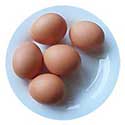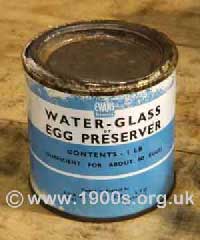How to preserve eggs using waterglass

Waterglass (or water glass) is a sodium silicate solution that can seal the pores in egg shells to stop them going bad. It was widely used in the past, particularly in WW2 when households kept chickens and there were no fridges. This page describes and explains various ways that waterglass was used and how the preserved eggs were used as required.
____
By the webmaster, based on firsthand contributions and talking to older people
What waterglass is
Waterglass - the sodium silicate solution that supposedly sealed the pores in the egg shells - is not to be confused with isinglass which can also be used to preserve eggs and has its own page.
How to spell waterglass
Three spellings seem accepted: 'water glass', 'water-glass' and 'waterglass'. You may have to try these alternative spellings if you are looking for waterglass online. It is still available from specialist shops.

Tin of water glass for preserving eggs, here spelled with a hyphen between the two words. Photographed at Llanerchaeron House.
Experiences of preserving using waterglass
contributed by Dick Hibberd from personal experience
We used to preserve eggs with waterglass in the war.
We bought the waterglass as a powder in a packet similar to that of a 2lb cardboard castor sugar packet. We poured the powder into a bucket and mixed in water until it reached the right consistency. It then looked rather like a cloudy grey and very liquid polycell wallpaper paste.
My mother had a large stoneware container with a lid. When she had any eggs to preserve, she simply poured the waterglass into it and lowered the eggs in one by one. Then she put the lid back on again.
I don't really know how long they could be kept, but at least a couple of months I think.
contributed by Chris Pillips from personal experience
We didn't leave our eggs in the waterglass liquid but just painted each one and left it to dry before storing. Sometimes it was a few months before we ate any.
contributed by Norman Groocock from personal experience
We had a stoneware jar of waterglass in the pantry. We didn't use it much, though, because we would really have needed to have a good source of eggs to make it worthwhile, and that meant keeping hens.
contributed by Sheila C MacIsaac from personal experience
When I was a child in Fife in the 1950s, my grandparents kept poultry on a small commercial scale.
Over the winter months eggs production was lower so my Grandmother preserved eggs for winter using waterglass in internally glazed earthenware jars which held 10 to 15 Litres.
The eggs were first cleaned with dry steel wool, then rubbed with lard to 'seal the pores' and then added to the jars in layers to just below the level of the liquid. The last task was to put the lids on the jars. These varied from custom-made wooden lids with handles to thick china plates, and in one case an enamelled pot lid. So insulation seems not to have been an essential requirement - just to keep free of dust and insects.
When the eggs were required they were used in rotation, jar after jar. We only used them for baking, never for boiling, scrambling or frying, as I understood that the consistency of the egg white might be altered after storage and would not cook well.
Preserved this way, the eggs could last the whole winter in a cold outhouse. Over the months a secondary white 'shell' of waterglass could build up over the egg shells but this was harmless and was ignored. Very rarely did an egg 'go off' but it didn't affect the others.
contributed by Arlene (Bodmer) Harouff, a family story and recollection
For many years I wondered what waterglass was because I had wondered if it was some old term that my mother made up. Then when I finally checked online, I found your site.
My mother was born in in 1911, and her family kept chickens. She told me how, as a small girl, she hated most of anything in her life having to go to the dark, cold cellar in the winter to get eggs from the crock of waterglass. It was not so bad getting the ones toward the top of the crock, but as time wore on she had to reach into the cold stuff up to her little shoulder. That made quite a lasting impression on her.
How we used the eggs preserved in waterglass
One of the following contributions mentions dried egg. This was available on ration during the war, imported from America. It was not something that UK householders could make.
contributed by Norman Groocock from personal experience
The eggs came out of water glass feeling slimy but as far as I can remember they were OK boiled. I preferred the dried egg for omelettes.
contributed by Chris Phillips from personal experience
There were a few failures I remember, but most of the waterglass eggs tasted OK.
contributed by Dick Hibberd from personal experience
When we needed an egg, it was simply lifted from the liquid, washed, and used in the normal way. I don't remember that the eggs tasted any different from fresh ones.
| sources | webmaster | contact |
Text and images are copyright
If you can add anything to this page or provide a photo, please contact me.



